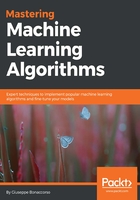
Underfitting
A model with a high bias is likely to underfit the training set. Let's consider the scenario shown in the following graph:

Underfitted classifier: The curve cannot separate correctly the two classes
Even if the problem is very hard, we could try to adopt a linear model and, at the end of the training process, the slope and the intercept of the separating line are about -1 and 0 (as shown in the plot); however, if we measure the accuracy, we discover that it's close to 0! Independently from the number of iterations, this model will never be able to learn the association between X and Y. This condition is called underfitting, and its major indicator is a very low training accuracy. Even if some data preprocessing steps can improve the accuracy, when a model is underfitted, the only valid solution is to adopt a higher-capacity model.
In a machine learning task, our goal is to achieve the maximum accuracy, starting from the training set and then moving on to the validation set. More formally, we can say that we want to improve our models so to get as close as possible to Bayes accuracy. This is not a well-defined value, but a theoretical upper limit that is possible to achieve using an estimator. In the following diagram, we see a representation of this process:

Accuracy level diagram
Bayes accuracy is often a purely theoretical limit and, for many tasks, it's almost impossible to achieve using even biological systems; however, advancements in the field of deep learning allow to create models that have a target accuracy slightly below the Bayes one. In general, there's no closed form for determining the Bayes accuracy, therefore human abilities are considered as a benchmark. In the previous classification example, a human being is immediately able to distinguish among different dot classes, but the problem can be very hard for a limited-capacity classifier. Some of the models we're going to discuss can solve this problem with a very high target accuracy, but at this point, we run another risk that can be understood after defining the concept of variance of an estimator.